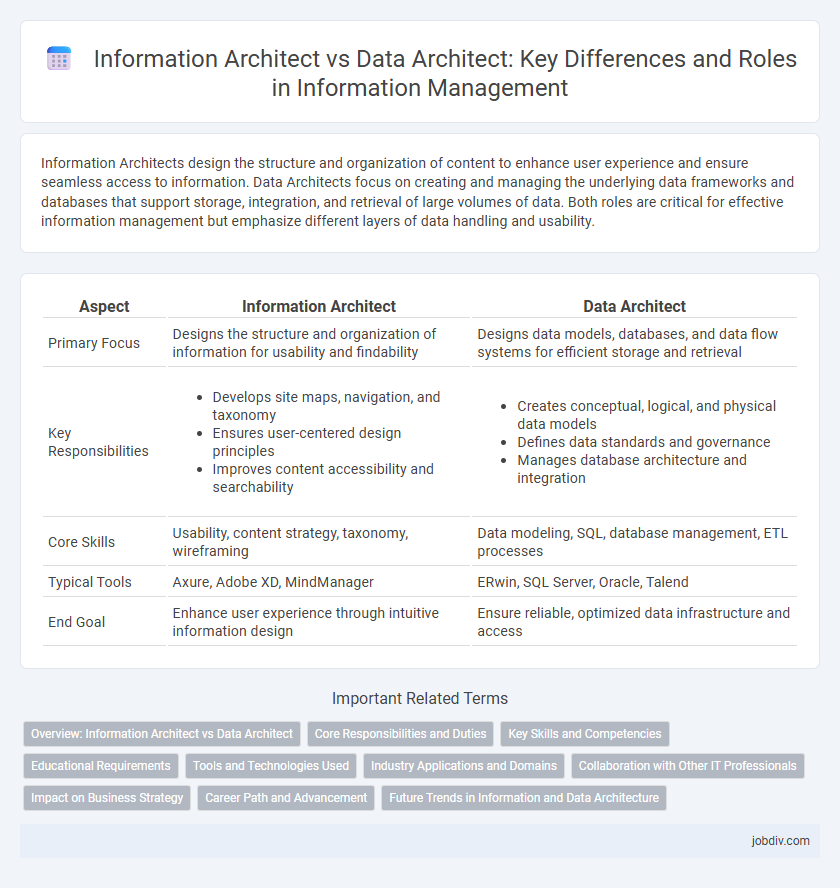Information Architects design the structure and organization of content to enhance user experience and ensure seamless access to information. Data Architects focus on creating and managing the underlying data frameworks and databases that support storage, integration, and retrieval of large volumes of data. Both roles are critical for effective information management but emphasize different layers of data handling and usability.
Table of Comparison
| Aspect | Information Architect | Data Architect |
|---|---|---|
| Primary Focus | Designs the structure and organization of information for usability and findability | Designs data models, databases, and data flow systems for efficient storage and retrieval |
| Key Responsibilities |
|
|
| Core Skills | Usability, content strategy, taxonomy, wireframing | Data modeling, SQL, database management, ETL processes |
| Typical Tools | Axure, Adobe XD, MindManager | ERwin, SQL Server, Oracle, Talend |
| End Goal | Enhance user experience through intuitive information design | Ensure reliable, optimized data infrastructure and access |
Overview: Information Architect vs Data Architect
Information Architects focus on designing the structure and organization of digital content to enhance user experience and accessibility, emphasizing taxonomy, navigation, and labeling systems. Data Architects specialize in creating and managing data models, databases, and infrastructure to ensure data integrity, scalability, and performance for business analytics and operations. Both roles require collaboration to align content strategy with data management for optimized information systems.
Core Responsibilities and Duties
Information Architects specialize in organizing, structuring, and labeling digital content to enhance user navigation and experience, focusing on usability and information flow within websites and applications. Data Architects design and manage large-scale data frameworks, emphasizing data modeling, database construction, and ensuring data quality and accessibility across systems. Both roles require collaboration with stakeholders but differ in their core focus: Information Architects prioritize content clarity and user interaction, while Data Architects prioritize technical data infrastructure and integrity.
Key Skills and Competencies
Information architects excel in organizing, structuring, and labeling digital content to enhance usability and findability, emphasizing skills in user experience design, content strategy, and information hierarchy. Data architects specialize in designing and managing data frameworks and databases, with core competencies including data modeling, database design, and knowledge of SQL and big data technologies. Both roles require strong analytical thinking and collaboration abilities but differ in their focus on user-centered content versus technical data infrastructure.
Educational Requirements
Information architects typically require a background in library science, information systems, or user experience design, often holding degrees such as a Bachelor's or Master's in Information Science or Human-Computer Interaction. Data architects usually have a stronger foundation in computer science, software engineering, or data management, with common degrees including Computer Science, Information Technology, or Data Science. Both roles benefit from certifications, but data architects often pursue specialized credentials like Certified Data Management Professional (CDMP) or AWS Certified Solutions Architect to enhance technical expertise.
Tools and Technologies Used
Information Architects primarily use tools like Axure RP, Adobe XD, and Sketch to design user-centered navigation structures and wireframes, focusing on enhancing user experience and content organization. Data Architects rely on database management systems such as Oracle, Microsoft SQL Server, and tools like ER/Studio, IBM InfoSphere Data Architect for data modeling, integration, and ensuring data governance. Both roles leverage visualization platforms like Tableau or Power BI but apply them differently, with Information Architects emphasizing content usability and Data Architects focusing on data integrity and analytics.
Industry Applications and Domains
Information architects specialize in designing user-centered structures for websites, intranets, and digital applications, primarily in industries like e-commerce, media, and education where user experience and content organization are critical. Data architects focus on creating data models, databases, and data management systems used in finance, healthcare, and telecommunications sectors, where data integration, security, and scalability are paramount. Both roles are essential for digital transformation but serve distinct purposes in information flow--information architects optimize content accessibility, while data architects ensure robust data infrastructure.
Collaboration with Other IT Professionals
Information architects collaborate closely with UX designers and content strategists to structure digital information for optimal user experience, while data architects work alongside database administrators and data engineers to design and manage scalable data infrastructures. Both roles require effective communication with software developers and IT security teams to ensure cohesive integration and secure data handling throughout system development. Their collaboration fosters seamless alignment between user-centered design and robust data management, enhancing overall IT project success.
Impact on Business Strategy
Information architects shape user experiences by organizing information to improve accessibility and usability, directly influencing customer satisfaction and engagement metrics. Data architects design data frameworks to ensure integrity, scalability, and compliance, enabling robust analytics that drive informed business decisions. Their combined impact aligns technological assets with strategic goals, optimizing operational efficiency and competitive advantage.
Career Path and Advancement
Information Architects typically focus on designing intuitive user experiences and organizing digital content, leading to career paths in UX design, content strategy, or digital product management. Data Architects specialize in structuring and managing complex datasets and databases, with advancement opportunities in data engineering, analytics, or chief data officer roles. Both fields require strong technical skills, but Data Architects often have higher demand in industries prioritizing big data and enterprise-level information systems.
Future Trends in Information and Data Architecture
Future trends in information and data architecture emphasize the integration of artificial intelligence and machine learning to enhance automated data management and intelligent information retrieval. Information architects will increasingly focus on designing adaptive user experiences that leverage semantic technologies and natural language processing. Data architects must prioritize scalable cloud-native solutions and data mesh approaches to handle complex, distributed data ecosystems efficiently.
Information Architect vs Data Architect Infographic

 jobdiv.com
jobdiv.com